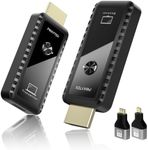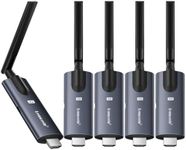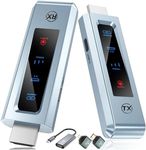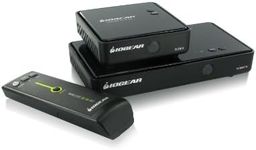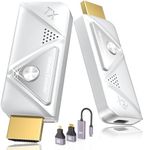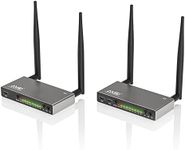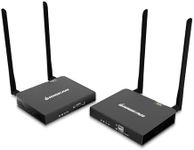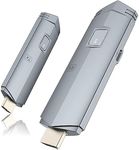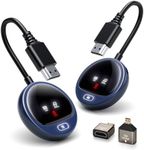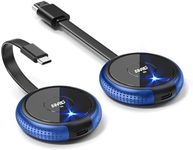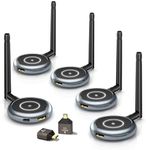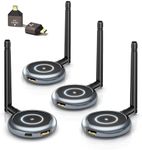Buying Guide for the Best Wireless Hdmi Transmitters
Wireless HDMI transmitters are devices that let you send high-definition video and audio signals from one device (like a laptop, gaming console, or Blu-ray player) to another (like a TV or projector) without using cables. They are great for keeping your space tidy, setting up home theaters, or sharing content in meeting rooms. When choosing a wireless HDMI transmitter, it's important to understand the key features that affect performance, compatibility, and ease of use. Knowing what each specification means and how it relates to your needs will help you pick the best option for your setup.Transmission RangeTransmission range tells you how far the transmitter can send the HDMI signal to the receiver. This is important because it determines where you can place your devices in relation to each other. Short-range transmitters (up to 30 feet) are good for small rooms or setups where devices are close together. Medium-range (30-100 feet) works for larger rooms or when you need to send signals through a wall or two. Long-range (over 100 feet) is best for big spaces, outdoor setups, or sending signals between floors. To pick the right range, measure the distance between your source and display, and consider any walls or obstacles that might interfere with the signal.
Supported ResolutionSupported resolution refers to the highest video quality the transmitter can handle, such as 1080p (Full HD) or 4K (Ultra HD). This matters because it affects how sharp and clear your video will look. If you mostly watch standard HD content or use older devices, a 1080p transmitter is usually enough. If you have a 4K TV or want the best picture quality for movies and games, look for a transmitter that supports 4K. Always match the transmitter's resolution to the highest resolution your devices can use to avoid losing image quality.
LatencyLatency is the delay between when something happens on your source device and when you see it on your display. Low latency is important for activities like gaming or video conferencing, where even a small delay can be noticeable. Latency is usually measured in milliseconds (ms). For casual movie watching, higher latency (over 100ms) is usually fine. For gaming or interactive use, look for transmitters with low latency (under 50ms) to keep everything in sync. Think about how sensitive you are to delays and what you'll use the transmitter for when deciding how much latency is acceptable.
Number of Supported DevicesSome wireless HDMI transmitters can connect only one source to one display, while others allow multiple sources or displays. This is important if you want to switch between devices (like a laptop and a game console) or send the signal to more than one TV. Single-device systems are simpler and work well for basic setups. Multi-device systems are more flexible but can be more complex to set up. Consider how many devices you want to connect now and in the future to choose the right type.
Interference and Frequency BandWireless HDMI transmitters use radio frequencies (like 5GHz or 60GHz) to send signals. The frequency band affects how well the signal travels through walls and how much it might be affected by other wireless devices. Lower frequencies (like 5GHz) can go through walls better but may have more interference from Wi-Fi networks. Higher frequencies (like 60GHz) offer faster speeds and less interference but have a shorter range and struggle with obstacles. If you have a lot of wireless devices or thick walls, look for a transmitter that can handle interference well or offers multiple frequency options.
Power SourceWireless HDMI transmitters and receivers need power, either from a wall outlet or USB port. Some are battery-powered for portable use. Wall-powered units are more reliable for permanent setups, while USB or battery-powered options are good for temporary or mobile use. Think about where you'll use the transmitter and whether you have easy access to power outlets when making your choice.
